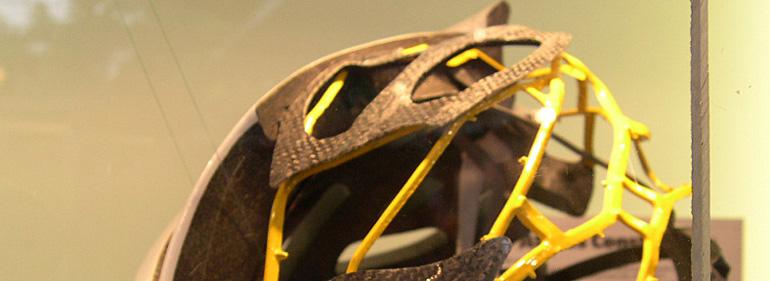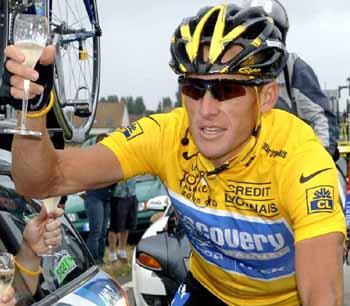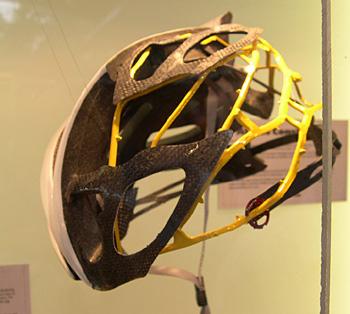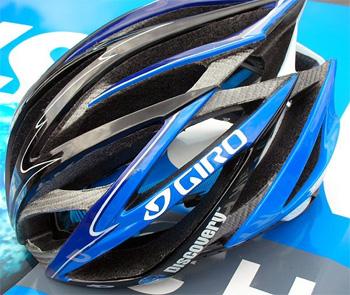 |
|||||||||||
 |
|||||||||||
|
By Cyclingnews staff During the Tour of California, Cyclingnews made a pit stop for a factory visit to Giro in Santa Cruz, California. Giro has been here almost from the beginning in 1986, when Jim Gentes created the first Giro helmet in his Northern California garage and paved the way for the groundbreaking Giro ProLight - considered the first lightweight cycling helmet. Since then, Giro has become synonymous with innovation and cutting-edge design, and close relationships with teams like the powerhouse Discovery and Rabobank squads, as well as seven-time Tour de France champion Lance Armstrong. Lance and Giro go back a long way together, as Giro demonstrates in its 2006 catalog homage to Mr. Armstrong. Among the evocative images is a photo of Armstrong winning a stage in the Tour DuPont while wearing a Giro Ventoux helmet. Another image is the poignant shot of Lance covered in grit and rain during the 1998 World Championships, wearing a Giro Boreas helmet en route to the his fourth place finish in the road race. It might have seemed like a frustrating result on a tough day for Lance, but it was a miraculous finish to a year that saw him return to the ranks of cycling's best after his battle with cancer. In his seven consecutive Tour de France wins, Lance wore Giro helmets exclusively and still does today in retirement. In fact, Lance is still at the heart of Giro's push to improve helmet design and performance through their ongoing collaboration and mutual dedication to developing ever faster TT helmets, and road helmets like the Atmos that are light, cool and comfortable enough for elite pros to wear every day. Giro marketing communications manager, Eric Richter, told Cyclingnews, "Our goal for Atmos was to create a helmet that Lance and even the climbers would wear in the Tour. It was driven by the need to reduce weight and improve ventilation - without sacrificing the integrity needed to pass the toughest standards." For Giro, mission accomplished as the Atmos - perhaps the most technologically advanced helmet on the market today - is the official lid of choice for Lance and his Discovery Channel cycling team, ProTour squad Rabobank and the US based TIAA-CREF team. Cyclingnews asked Richter how Giro makes a helmet that meets these challenges and he explained, "our approach is to work towards the highest standard of product design. Besides the Atmos' 26 Wind Tunnel vents and extensive internal channeling, the helmet features our unique I.C.R reinforcement, where we use In-mold technology to fuse carbon fiber 'plates' into the helmet's EPS foam liner. The I.C.R system works with the outer shell of the helmet and a full Roll Cage embedded in the EPS to provide incredible durability and integrity for a helmet that is so light (275g) and ventilated." The superb fit of the Atmos is based on Giro's proprietary Super Fit sizing system, which was developed from a large database of "human scale factors" (Giro's fancy term for anatomical measurements and studies) and further honed with years of test rider feedback. The fit is fine-tuned via Giro's patented Roc Loc 4 fit system, which adjusts the vertical position of the helmet as well as the fit tension. In all, it's simple to use and leads to a helmet that practically disappears when you put it on. It's interesting to note that Giro's very first design was an aero helmet called 'Advantage' that was crafted for triathletes back in 1985. Among the Advantage's innovations were the use of computer aided design; a textured surface to improve airflow, and internal channels for enhanced ventilation. Over the years, Giro has stayed on the leading edge of aero performance with sleek designs that Grand Tour champions, Ironman winners and time trial specialists count on; sometimes even choosing to use Giro helmets over their own sponsor's offerings. In 2005, after years of creating TT helmets that were only available to elite professional riders, Giro made a dramatic step forward and released a CE certified TT helmet for the European market. Giro returned to the name 'Advantage' and rightly so, as the Santa Cruz firm has more experience than anyone in creating the sleekest, fastest TT helmets. Cyclingnews asked Richter to explain the benefits of the Advantage and he told us, "this helmet has a very compact profile, with six front vents and deep internal ventilation channels to keep riders cool. But the biggest advantage is the group we work with and the years spent in the wind tunnel with Lance. It's a special team that has been together a long time, and no other company has that kind of depth to draw on." And while Giro couldn't confirm all of the details just yet, Richter hinted that that "plans are in the works for a CPSC compliant version of the Advantage that will be available in the US. It's in development now." Richter further explained that, "performance criteria is very high for a CPSC design, and so we have to raise the bar for a helmet in this category. But we believe that a CPSC Advantage helmet will be ready in 2006." Giro is also considered the leading helmet brand among mountain bikers. "That might be a surprise to some," admits Richter, "but we work hard to earn our success off-road, and some of our closest relationships are with the guys like [freeride specialists] Richie Schley and John Cowan; guys who inspire us to be a step ahead in helmet design. After all, when you ride as big as they do, it's pretty important to have a great helmet on your head." While Giro's Mad Max was already legendary among the gravity set, the company decided it was time to develop a new helmet for more aggressive riding. So Giro's designers tapped team riders like Schley, Thomas Vanderham and two-time Crankworx champ Paul Basagoitia for input and feedback on a completely new helmet design that emphasizes lighter weight and more impact management capability. The results are Giro's Remedy and Remedy CF (carbon fiber) helmets, which are the first helmets to be specifically designed around the new downhill-specific standard, called ASTM 1952. Weighing in at only 900 grams, the Remedy and Remedy CF are incredibly light for a full-face design of this caliber. Plus both models and incorporate a removable / adjustable visor and a removable and washable pad set. All three of Giro's newest helmets, Atmos, Advantage and Remedy, reflect Giro's heritage, which for over two decades has been a unique focus on creating great cycling helmets. "At Giro, we have always created products with a special rider-driven emphasis", Richter proudly stated. "Working with Tour de France champions like Lance Armstrong and freeriders like Schley, we are able to create helmets that any rider can appreciate." Before we left Giro's HQ in Santa Cruz, Richter hinted that Giro wasn't finished yet with new product innovation, telling Cyclingnews, "you should probably look out for some new stuff from us soon." We found out what he meant on July 1 when Giro gave us a sneak peak of the new Ionos helmet, which takes Giro's helmet technology "up to eleven" with lower weight and dramatically increased ventilation. Further reading
|
||||||||||




